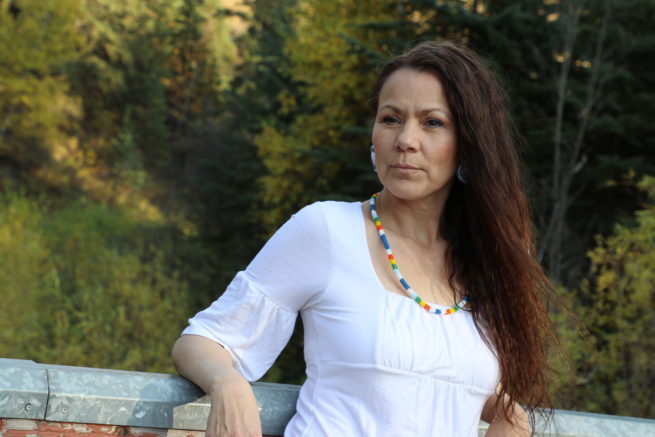Plains People (the Cree, Assiniboine, Siksika, and Anishinaabe to name a few) used to gift buffalo robes—tanned hides—by draping them around the shoulders of warriors and hunters when they returned from battle or a successful hunt, or completed the Sundance ceremony. Today, the modern equivalent is a quilted star blanket.
To receive a star blanket indicates that the giver holds you in high esteem. When Andrea Bellegarde-Courchene was growing up, she didn’t yet know about this cultural practice. Bellegarde-Courchene, a skilled fiber artist from Little Black Bear First Nation in Treaty Four, learned to craft the blanket from a cousin. She resisted learning at first. “They looked really difficult and I didn’t feel I was capable of it.”

But after a fall that left her on medical leave for three months, she felt restless. She remembers one morning when she was pacing around the house, from the bedroom to the living room to the kitchen. “I couldn’t even lift my grandson up,” says Bellegarde-Courchene.
“I can honestly say that learning to make them saved me from falling into a depression. It took me two months to make my first blanket, and I’ve been making them ever since,” says Bellegarde-Courchene. At that time, she also got into making ribbon skirts and ribbon shirts.

She was contracted to make 10 blankets for a Sundance ceremony. “Every time I would sew, I would play Sundance songs, and then I found a few videos on the teaching,” says Bellegarde-Courchene.
The whole crafting process felt healing, and crafting has been her way to heal and connect to her Cree/Anishinaabe roots. She recalls that she wrapped herself in one of the blankets. “I could just feel myself staring to move. I think that is when I started understanding that my culture is coming out and I am embracing it,” says Bellegarde-Courchene.
Bellegarde-Courchene got into sewing thanks to her mother-in-law, who had her own company. She is not Indigenous but had a wealth of knowledge in the craft. Bellegarde-Courchene used those skills to earn a living. “My job was a sewing job. I used to make hardhat liners for the oil rigs for two years straight,” she says.

Her friend Rebecca Pickard nominated Bellegarde-Courchene for an award through the Edmonton Artists’ Trust fund. The EATF is designed to invest in Edmonton’s creative professionals and to encourage artists to stay in our community.
“I am just so glad to see her work being recognized because she doesn’t have a similar background to other artists you hear about and her work is so beautiful,” says Pickard.
The funds are intended to offset living and working expenses, allowing the artists to devote a concentrated period of time to their artistic activities, career enhancement and/or development.
Bellegarde-Courchene says, “I was just really happy at that point that she wanted to nominate me. It just made me feel like a recognized artist. You know you get that imposter syndrome. So that was really exciting. Receiving the grant just blew my mind.”
With this grant, Bellegarde-Courchene plans to focus on the more artistic aspects of her craft. “I want to make a panel of quilts, and they all represent a page in a story book about our past and present, and the future of our people.”
[kpcta href=” https://grants.edmontonarts.ca/eac_grants_-_grants_and_awards_for_individual_artists/eatf/”]Learn more about the EATF[/kpcta]
